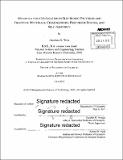Manipulating Conjugation in electronic polymers and graphitic materials: chemosensors, precursor routes, and self-assembly
Author(s)
Weis, Jonathan G. (Jonathan Garrett)
DownloadFull printable version (26.01Mb)
Other Contributors
Massachusetts Institute of Technology. Department of Chemistry.
Advisor
Timothy M Swager.
Terms of use
Metadata
Show full item recordAbstract
In Chapter 1, we synthesize dithienobenzotropone-based conjugated alternating copolymers by direct arylation polycondensation. Post-polymerization hydride reduction furnishes cross-conjugated copolymeric hydrogels that undergo phosphorylation and subsequent ionization upon exposure to chemical warfare agent (CWA) mimics. The resulting conjugated, cationic copolymer is intensely colored and facilitates spectroscopic and colorimetric detection of CWA mimics in solution and as a thin film. Similarly, we report the incorporation of CWA-responsive units into random copolymers prepared by ringopening metathesis polymerization (ROMP) to create highly modular, chromogenic thin films. In Chapter 2, we explore homoconjugated polynorbornadienes possessing various electron-withdrawing groups as polymeric precursors to electron-accepting poly(cyclopentadienylene vinylene) derivatives. Tungsten oxo alkylidene catalysts were utilized to polymerize a variety of 7-isopropylidene- and 7-oxa-2,3-disubstituted norbornadienes in a cis-highly tactic fashion by ROMP. We further demonstrate the excellent scope of tungsten oxo complexes by polymerizing norbornadienes that are unreactive with traditional molybdenum-, tungsten-, and ruthenium-based catalysts. In Chapter 3, we employ atomic force microscopy (AFM) and scanning tunneling microscopy (STM) to examine graphene oxide (GO) samples with gradations of (de)oxygenation. We analyze the roughness of the apparent height in STM topographic measurements - i.e. the "apparent roughness" - and report a correlation between increasing deoxygenation and decreasing surface roughness. The "apparent roughness" therefore serves as a supplemental technique for analyzing samples of GO. Furthermore, we report the first example of using an STM tip to locally reduce GO without local destruction of the graphene sample. In Chapter 4, we exploit the extraordinary self-recognition properties of deoxyribonucleic acid (DNA) to assemble single-walled carbon nanotubes (SWCNTs) in a controllable manner. Networks of SWCNTs with three-way junctions could be constructed in solution or sequentially on a surface. We envision that more complex nanoscale architectures and circuits can be prepared in this bottom-up manner. In Chapter 5, we introduce halogen bonding in SWCNT-based chemiresistive gas sensors. These chemiresistors were prepared by ball milling of SWCNTs and selectors, compression into a pellet, and mechanical abrasion between gold electrodes on paper. We demonstrate that sensing responses reflect halogen bonding trends, with some exceptions. The predominant signal transduction mechanism is likely attributed to swelling of the insulating haloarene matrix.
Description
Thesis: Ph. D., Massachusetts Institute of Technology, Department of Chemistry, 2015. Cataloged from PDF version of thesis. Includes bibliographical references.
Date issued
2015Department
Massachusetts Institute of Technology. Department of ChemistryPublisher
Massachusetts Institute of Technology
Keywords
Chemistry.